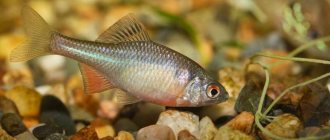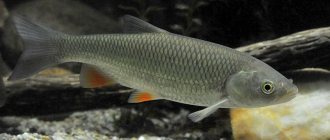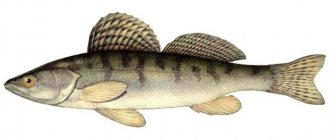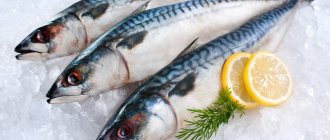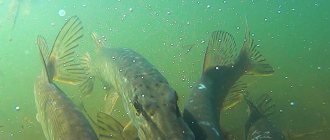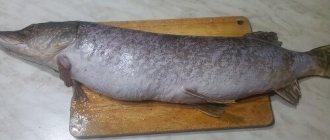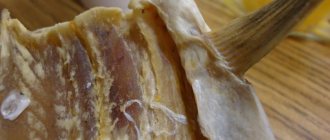What types of pike exist
There are several species of pike in nature, most of them have a sufficient population, but there are varieties that are protected by the legislation of the countries in which they live. The most common and well-known is the common predator, the rest are less common, and therefore not everyone knows about them.
All pikes are united by certain external characteristics, among which are:
- elongated snout;
- torpedo-shaped or cone-shaped body;
- spotting over the entire surface, the only exception being an albino;
- the location of the fins will also make it possible to recognize the caught fish as a pike;
- cannibalism, that is, eating one’s own relatives, is also characteristic of all species of this predator;
- a row of sharp teeth turned inward is found only in pike.
Competitions are often held to catch pike, but not all species are caught. Some do not grow very large, so they are of no interest in this case. In North America, there is a species of pike whose caviar is toxic, and the meat is not very tasty and has practically no value, which is why the population is very large.
Next, we will dwell in more detail on the main characteristics of all known species of pike.
Facts about pike
In addition to its specific appearance, pike has many other differences.
Natural enemies
The pike itself is a predator and has few enemies. The exception is otters and eagles, which sometimes hunt it and are very successful. In the southern regions, pike can be attacked by catfish.
Small-sized representatives are also hunted by perch, rotan, and large pike perch. The pike is also destroyed by the person for whom it represents a real trophy.
How does a pike attack in water?
The pike attacks the victim quickly, making 1 or 2 bites with its jaws. Once in the mouth of a predator, small fish are practically doomed to death, since their teeth literally cut like a razor. Having swallowed the bait, the pike pulls it into the shelter, so you cannot immediately pull out the predator.
After some time, the pike will try to turn the bait over and swallow it (about 15 seconds after the attack).
Why is pike called a freshwater shark?
Due to its aggressiveness and gluttony, pike is sometimes called a freshwater shark. The predators have a lot in common: both love to swim alone and feed on small fish, shrimp and crustaceans. They do not attack humans, but behave aggressively.
The lifespan of sharks reaches 30 years, and pikes, in most cases, live much shorter lives (up to 7 years) due to pollution of rivers and reservoirs. There is also a difference in size - sharks are much larger than giant pike.
What happens if you throw a pike towards piranhas?
Teenagers sometimes undertake such experiments for the sake of an interesting video on YouTube. The problem is that piranhas live in a different environment than freshwater pike and, once in the wrong environment, the toothy predator immediately dies.
Is a pike bite dangerous, have there been attacks on humans?
A pike can bite a fisherman. Such cases have happened more than once. A fish bite can be dangerous because the predator's teeth are very sharp and mobile. It is advisable to always have a patch, brilliant green or iodine with you to treat the bite site.
You should only climb into the mouth of a fish using a gaper so that it does not have time to close its mouth and injure your hand.
Ordinary

The most common type of toothy predator is the common pike. It is found in almost all freshwater bodies of Europe, North America, in the Aral Sea basin and in Siberian rivers and lakes. An adult can reach one and a half meters in length, and its weight sometimes exceeds 10 kg, but on average it weighs no more than 8 kg.
There are two subspecies of the predator: grass and deep. The body color can be different, it depends on the habitat of the fish. This species may have the following colors:
- greenish-gray;
- brown;
- grey-yellow.
In this case, the tummy will always remain light.
It is not picky when it comes to nutrition and does not disdain anything in its territory. It can even defeat smaller tribesmen without a twinge of conscience.
The fry stay in flocks for some time; adults prefer a solitary lifestyle. They prefer to stand in thickets and snags and look out for potential victims from there.
Reproduction and offspring
Pike are actively breeding. The predator's fertility is up to 200 thousand eggs 3 mm in diameter. The ideal depth for spawning can be from 0.5 to 1 m in places with sparse algae thickets. When spawning, the female lays eggs, and several males, following her, water her with milk.
The eggs attach to the plants, and then fall off and lie on the bottom of the reservoir. It takes 8-14 days for the fry to develop. At first, their diet includes small crustaceans, later - fry of other fish. Puberty of pikes occurs at 2-4 years.
River pike, 2 weeks after spawning, makes forays into fast water to shallow riffles. When casting in shallow water, you must immediately reel in the line at a given pace so that the nozzle does not become clogged with plant debris.
The success of fishing with “dirty” live bait decreases significantly. The main trophy during the spring pike feast is individuals up to 2 kg. Large ones are found less often than in August and September.
How to distinguish a male from a female
The male differs from the female in the type of urogenital opening. In males it looks like an oblong slit, and in females it looks like a depression. Male pike are smaller in size and have a more slender body than females.
How many times a year does spawning occur and at what time?
Spawning time is spring (from early March to May). The ability to reproduce occurs by 2-3 years, when the body length reaches 30-35 cm. Spawns at a fairly low temperature (4-6 ⁰C).
On the approaches to spawning grounds, at a depth of 0.5-1 meters, clusters of fish form, and there are usually several males around one female.
Pike fishing is not allowed during the spawning period from March 1 to April 15-25. In Belarus, fish spawn even earlier - at the very beginning of March. The timing and timing of spawning depend on the climate and region where the fish live.
The warmer the water, the faster the process occurs. The optimal water temperature for pike spawning is 5-7 degrees.
A group consisting of one female and several males constantly moves around the spawning area. It often happens that in those reservoirs where wastewater is discharged, eggs die.
After spawning, the pike recovers for about a week, actively absorbing food. To restore strength, she needs to actively eat. It is during this period that you can actively hunt for a predator, since it is ready to grab any bait.
Zhor after spawning occurs at the end of April-May. This period is considered by fishermen to be the most successful for hunting predators.
But during the spawning period, catching is prohibited. Violation of the ban will result in the payment of a substantial fine (up to 300 thousand rubles). The ban is being introduced specifically to prevent the population of this valuable fish from being limited.
What does a pike fry look like and what is it called?
The pike fry, or “little pike,” is initially green in color and looks like its little parents. But after a year, the squinting becomes gray in color with characteristic spots on the body. Children of pike are characterized by a size of up to 20 cm and a weight of up to 1 kg. They are caught from August until late autumn.
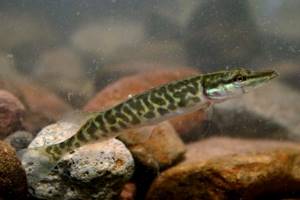
How many years does he live?
Pike lives on average 7 years. The maximum age of pike in commercial catches does not exceed 20 years. There is also information in the media about the capture of a 33-year-old pike.
How to determine age by weight and size
Usually the age of a pike is determined by the annual rings on its scales. You can accurately determine the age only by dissecting the pike's head and examining its bones. This is mostly done by professionals, since it is very easy to make a mistake.
It is believed that if a pike is small - 25-35 cm, then it is no more than 1-2 years old. If a predator reaches a meter, its age can be very large, including up to 20 years.
Black pike

This species is also called striped pike and lives in water bodies of eastern North America. Characteristic features of the species are:
- relatively small in size, the length reaches only 60 cm maximum, but the weight can be 4 kg;
- differs from the common pike by dark stripes above the eyes;
- the snout of black pike is shorter than that of other members of the family;
- It also has a mosaic pattern on the sides; it resembles stripes or links.
The diet will also differ; the predator prefers to feed on invertebrates and small crustaceans. For habitat it chooses dams with a lot of vegetation.
Sexual maturity of black pike is reached at different times, usually 1-4 years. For spawning, each female needs a pair of males. She lays from 6 to 8 thousand eggs at a time.
Age and size of pike
The size and weight of large pikes are legendary. Leonid Sabaneev mentions the legendary pike caught in 1497 in Germany; the ring of the Holy Roman Emperor Frederick II, marked 1230, was found on the pike. Thus, according to this legend, the fish was 267 years old, weighed 140 kg and had a length of 5.7 meters. The spine of this legendary pike was transferred for safekeeping to the cathedral of the German city of Mannheim. Scientists examined this spine and found that it was just a hoax; the spine was assembled from the vertebrae of several individual pikes.
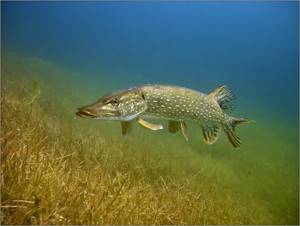
The history of Tsar Boris Fedorovich’s pike is known. Legend has it that in 1794, while cleaning the Tsaritsinsky ponds, a pike with a ring on the gill cover was caught. The inscription “Planted by Tsar Boris Fedorovich” was engraved on the ring. Thus, it turned out that the caught pike was more than 200 years old. This whole story is nothing more than a legend; no documentary evidence of this story has been preserved.
According to legends that have come down to us, pike weighing 56 kg were caught in the Ural lakes, a pike weighing 64 kg was caught in Lake Onega, and a specimen weighing 80 kg was caught in the Vychegda River.
The maximum size of pike reaches, apparently, 1.6 - 1.9 meters, maximum weight 26-35 kg, this is indicated by documented data on the industrial catch of pike.
In order to grow to a weight of 20 kg, a pike must live more than 30 years. It is possible that such huge pikes are still preserved somewhere.

The largest pikes live in wild northern rivers, rarely visited by people; in such places, predators can live to a very old age.
Most often, anglers catch pike with a maximum length of 50 - 70 cm, weighing 1.2 - 3 kg. Pike weighing from 3 to 7 kg are considered large these days. Specimens weighing more than 8 kg are already considered trophy; many fishermen have never managed to catch a fish of this size in their entire lives.
There are legends that pike can live up to 100 years, but these are just legends, the average life expectancy of pike is 18-20 years, under ideal conditions pike can live up to 30 years. But pike, as a rule, do not live to this age, due to catch by fishermen, death in winter from lack of oxygen in the water and freezing of reservoirs to the bottom in especially cold winters.
Amur pike
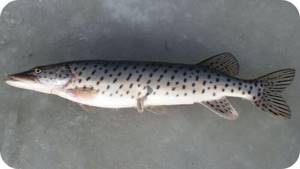
The name speaks for itself, the habitat gave its name to the species. Amur is found in the Amur basin, as well as in some reservoirs of Sakhalin.
Features of the Amur pike are:
- silvery or golden color of the scales;
- dark spots on the upper body;
- adult size up to 115 cm;
- maximum registered weight 20 kg.
Inexperienced fishermen often confuse Amur pike with taimen; their body shape and color are very similar.
What does pike eat?
Pike is a predatory fish that feeds on a wide variety of animal foods. The basis of the pike diet is all kinds of fish. Already, pike fry, whose size barely reaches 1.5 cm and the basis of their diet is zooplankton, are trying to hunt the larvae of various small fish. Having reached a size of 5 cm, pike completely switch to feeding on fish.
Pike are not particularly picky about their diet; they eat whatever they can catch. Among the fish, pike prefer: crucian carp, roach, bream, silver bream, perch, goby, whitefish, bream, roach, ruffe, gudgeon, char, and minnow.
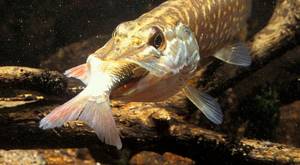
Pike treats ruffs, perches and pike perch with caution, which have sharp fins and can injure the pike with them. Pike does not really like burbot and tench because of their unpleasant mucus. Having caught a ruff or perch, the pike squeezes it with its jaws for a long time until it feels that its victim has completely stopped resisting and only then swallows it.
You may be interested in: Sunline FC Sniper Fluorocarbon Line
Pike often eat other pike if they are smaller in size. Anglers often catch large pike weighing up to 4 kg, with lacerations on their sides. Such wounds indicate that there are even larger pikes in the reservoir, and the caught pike became a victim of their attack. A pike weighing 15 kg, which is 20-25 years old, can eat another pike weighing 8 kg.
In spring and the first half of summer, pike happily eat frogs and molting crayfish. In autumn, during migration, various rodents (mice, rats and squirrels) swim across rivers and often become prey for large pikes. A large pike can grab and drag a duckling, and sometimes even an adult duck, under water, especially during molting, when the duck has difficulty rising into the air. Cases are mentioned when pikes even grabbed geese.

The gluttony of the pike is evidenced by the fact that it is able to swallow food reaching a size of 50-65% of its own weight and size.
Having caught the prey, the pike turns it head first and then swallows it; if the pike cannot swallow its prey completely, it waits until the swallowed part of the prey is digested and then swallows the rest of the prey.
Food in the stomach of pikes is digested very slowly, which is why pikes are so voracious, they have to fill their digestive tract completely to capacity. The pike regurgitates scales and other solid undigested food debris.
Pike feed irregularly; after eating, the pike can digest food for several days and not hunt during this entire time.

The time when pike are actively feeding is commonly called zhor by fishermen. There are three periods of pike feeding: pre-spawning feeding occurs in early spring, post-spawning feeding occurs in April-May, and autumn feeding occurs in the fall with cooling temperatures.
The time of active feeding can be determined by the behavior of the pike. During zhora, the pike often jumps out of the water and starts a fry fight, during which the fry jumps out of the water in different directions. It happens that, carried away by the pursuit of a fry, a pike even jumps out onto the shore during a feast.
American pike

The species differs from its relatives by its shortened snout and the relatively small size of adult individuals. Life expectancy is only 10 years, average length is 35-45 cm with a weight of about 1-1.5 kg.
The species is also called redfin pike; it has two subspecies:
- northern redfin;
- southern herbal.
It lives in the eastern part of North America; it feels most comfortable in ponds with a high level of algae, and chooses reservoirs with standing water.
Pike fishing methods
Pike is caught throughout the year. Large individuals more often bite the bait in the morning, and in windy weather - in the middle of the day. On cloudy days, fishing is more successful than on sunny days.
When fishing for a pike on a spinning rod, it can shake its teeth and jump off, so you need to be very careful. The secret to a successful hunt is to search for hidden “pike” places (deep, snag areas, whirlpools, rolling holes).
Amateur and poaching gear
They catch the predator with a spinning rod, a line, winter live bait, float and bottom fishing rods, mugs and other gear. For fishing on a large scale, fixed nets are used. They often catch it from the shore with live bait, in the pools with a sinking wobbler, and from a boat with tackle with a large bleak.
Used for fishing:
- supply;
- girder;
- circle;
- live bait fishing rod;
- winter harness and other gear.
Poachers use various methods, including traps that are not prohibited by law.
Hunting for live bait is prohibited on the territory of wintering pits while the corresponding ban is in effect.
Otherwise, you can fish in all permitted fishing areas all year round. When fishing for live bait, you can use up to five gear (rods, circles, girders or donks), with a total number of hooks equal to five.
Unconventional fishing methods
Unconventional methods are also used to catch predators. For example, fishing with unloaded rubber with imitation fish in places where there is a high risk of catching classic baits: spinners with a tee or wobblers.
Silicone baits of various sizes (mainly for small fish or shrimp) are superior to all other types of devices for catching predators.
The bait is thrown into the water and the fishing line is reeled in. During this process, the bait begins to vibrate, attracting a predator. For fishing, they also use a trap (single or double), jamming on the first ice, and sometimes a crossbow or bow.
Muskinong
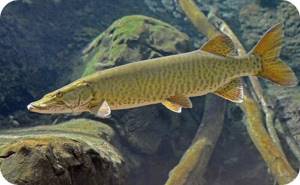
The toothy predator received this unusual name from the Indians; in their language this is exactly what “ugly pike” sounds like. Its habitats are quite limited; it can only be found in North America, and even then not often.
Unlike the American pike, the muskie lives about 30 years, and can grow to almost two meters. The maximum recorded weight of the fish was more than 40 kg, but it is allowed to take it when catching no more than 20 kg.
For the first ten years it actively feeds and grows in length, then this process stops. It shows predatory tendencies in its diet in the first year of life. Maskinong has three subspecies, their characteristics differ from each other.
| muskie subspecies | color characteristics |
| striped or common | has dark stripes on the body |
| spotted | there are dark spots on the silvery scales |
| clean or bare | no stripes or spots on the body are visible |
All subspecies will be united by the presence of seven sensory points on the lower jaw.
It is this species of pike from the North American continent that is considered a giant; individuals of muskie are considered the largest among pike representatives.
Appearance
Pike body
The pike has a torpedo-shaped elongated body, with fins shifted towards the tail. The whole appearance of the pike speaks of its ability to develop high speed with lightning speed.
Pike fins have a rounded shape, their whole appearance speaks of the excellent hydrodynamic properties of the pike. A long body with large dorsal and anal fins and a muscular tail give the pike the ability to move quickly. True, it can only pursue its prey in short bursts.
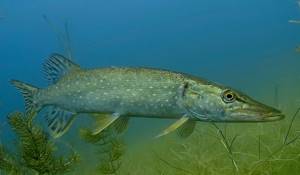
The pike has a large, elongated head, a wide mouth, and the lower jaw protrudes slightly forward.
The pike's snout is wide and elongated, somewhat reminiscent of the muzzle of a crocodile. The pike's mouth has a large gripping area; the gill membranes are separated from each other, allowing the pike to open its mouth very wide. Thanks to this, the pike can swallow food of large sizes, up to 2/3 of its own length. Fishermen know this feature of pike, so they often use large baits when fishing for pike.
The entire body of the pike is covered with small scales closely adjacent to each other, which form a dense monolithic cover that reliably protects the body of the pike from the teeth of other pikes.
Body coloring
Pike differ greatly from each other in color. The color can be very different and depends on the age of the pike, the aquatic environment, food supply and other environmental conditions.
The main color of pike scales is gray-green; spots of different shades from yellowish and olive to brown are scattered on a gray background. The spots form transverse stripes on the sides of the pike. The back of the pike is dark, the belly is light yellow or grayish-white.
The coloring of pike has an important camouflage function. A camouflage pattern of transverse stripes and spots scattered throughout the pike’s body makes the pike invisible in the pond. The camouflage pattern on the pike’s body is especially effective in areas with dense vegetation and snags.
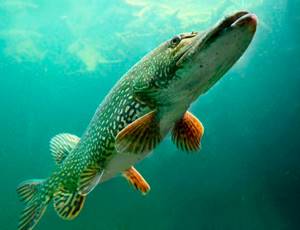
The color depends on the age of the pike: young pikes have a lighter color, adults have a darker body color.
The color of pikes greatly depends on their habitat. Pike living in peat and silted reservoirs have a dark body color. Pike living in reservoirs with clear water and a sandy bottom are light in color. Pike living among underwater vegetation, the so-called grass fish, have a greenish body color.
The paired fins of pike are orange or red, the unpaired fins are yellowish-brown, brown or gray with light streaks and stripes.
Females and males of pike do not differ in body color. The female differs from the male in the larger size and shape of the urogenital opening. The urogenital opening of a female pike is an oval depression surrounded by a pink ridge, and in males it looks like a narrow oblong slit.
Mouth, vision, sense organs
The pike has good eyesight, its wedge-shaped snout is designed in such a way that the high-set eyes of the pike allow it to see very well what is in front of it, above it, on the sides of it and even just below it if the object is slightly ahead.
The wide mouth prevents the pike from seeing objects that are below it at a close distance.
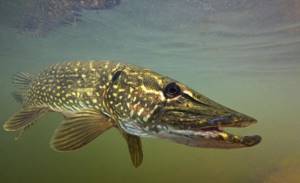
Pike have binocular vision and can well determine the distance to moving objects and the speed of their movement. Scientists' experiments show that pike can distinguish more than 20 color shades.
Pike has a well-developed olfactory apparatus, thanks to which at certain periods it can feed on carrion from the bottom of the reservoir.
The pike has a well-developed lateral line organ. Thanks to this organ, pike can hunt even in muddy water and detect the source of the slightest fluctuations in water from a great distance.
Experiments show that even a completely blind pike can successfully obtain food for many years, precisely thanks to the lateral line organ.
Predator teeth and their replacement
The pike's huge mouth is lined with sharp teeth. All pike teeth are not used for chewing food, but for capturing and killing prey. Some of the teeth are located on the jaws; they look like sharp fangs of different sizes, located at some distance from each other.
In addition to the fangs, on the jaws, palate, tongue and cheeks of the pike there are bristle teeth that resemble the bristles of a toothbrush in appearance. The bristle teeth are directed with their sharp ends towards the pharynx and in the normal state are immersed in the mucous membrane. These teeth help the pike hold on and make it easier to swallow prey. When the prey tries to escape from the mouth, the bristle teeth rest against it with their tips and do not allow it to slip out, pushing the prey further into the throat.
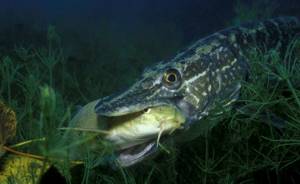
There is a legend among fishermen that after spawning and during the full moon, the pike’s teeth change and because of this it stops feeding and is not caught at this time.
In fact, the change of teeth in pike is a continuous process that occurs constantly throughout the life of the pike. The change of teeth in pike has no connection with spawning and the full moon. The passivity of pike and the lack of biting is not associated with a change of teeth, but is explained by a loss of strength due to spawning.
Each tooth in the lower jaw of a pike is adjacent to 2-4 replacement teeth, which are hidden under the soft tissue of the inner surface of the jaw. The active tooth and its replacement teeth together form a dental family. When a pike's working tooth goes out of use, its place is taken by a replacement tooth; at first it is soft and not very stable, but then its base grows to the pike's jaw and becomes strong.
You may be interested: Jackall Chubby 38F – big-faced killer
The change of teeth does not occur simultaneously in pike. If you examine the teeth of a caught pike, you will see old, dissolving teeth, strong working teeth, and new, still mobile, young teeth.
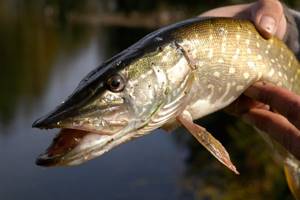
The sharp teeth of a pike can cause a lot of trouble for inexperienced fishermen who have not yet learned how to properly handle the caught fish. Even a scratch from the small teeth of a small pike is very painful and does not heal for a long time. In addition to the teeth, the sharp edges of the pike's gill covers, which can easily cut oneself, pose a danger to the fisherman.
You need to remove the caught pike from the water with a special landing net. Before handling a pike, it is advisable to wear gloves with a protective coating. To remove the bait from the pike's mouth, its mouth is securely fixed with a gaper, and the bait itself is removed with an extractor, while the pike's head is carefully held with one hand under the gills, pressing it against a hard surface.
Aquitaine
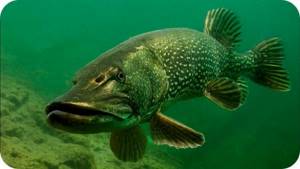
The youngest representative of the pike, it was described as a separate species only in 2014. The peculiarity of this species is its very limited habitat; it can only be found in freshwater bodies of France.
At the moment, these are all officially registered species of toothed predator. Scientists are still arguing about another one; some believe that the hybrid of common pike and muskellunge should be isolated separately. Others emphasize that these individuals cannot reproduce on their own, therefore they cannot be made a separate species.
The benefits and harms of pike for humans
Pike has a lot of useful properties and has a beneficial effect on the human body. Its only drawback: fish caught in dirty waters will most likely be infected with harmful bacteria or even parasites, so it is better to avoid hunting in such places.
What are the benefits of meat and liver for humans?
Pike meat contains 1-3% fat and is a dietary product (100 grams of pike contains only 84 kcal). Meat contains vitamins PP, E, C, B9, B6, B2, B1, A, and many valuable minerals. Pike is often recommended for those who have problems with the heart, blood vessels, and a predisposition to diabetes.
Fish oil regulates blood cholesterol levels and has a positive effect on the gastrointestinal tract. Pike caviar normalizes blood pressure and increases hemoglobin in the blood. The liver of a predator is considered a real delicacy, as it contains a lot of healthy fat and microelements.
Pike meat is often fried in batter and used for dietary salads and other dishes. The liver of a predator contains vitamins (B1, B2 and PP), which improve the metabolism of fats and proteins in the body. Pike contains a lot of phosphorus, iron and calcium. They are necessary for those who are engaged in mental activity or study.
However, fish also has disadvantages. It can accumulate harmful bacteria and substances if it is in bodies of water where sewage flows, so it is best to eat fish caught in environmentally friendly places.
Does pike have opisthorchiasis, tapeworm or other parasites?
As with any river fish, pike can contain parasites. They look like thin threads or large worms, but, for example, opisthorchises are not visible to the human eye at all and cannot be detected when cutting.
Tapeworm is one of the most dangerous parasites; it looks like a large flat white worm. The consequences of eating contaminated fish can be very serious: opisthorchiasis can provoke oncological pathologies, digestive disorders, dyspeptic disorders, and intestinal obstruction syndrome.
In addition, symptoms of a nervous system disorder may occur. In addition, fish infected with helminths is tasteless and actually spoiled.
Helminths can be found in the gills, inside the abdominal cavity and other places. If parasites are found, the fish should not be eaten even after cleaning and rubbing with salt. But if the helminths are not visible, freezing will help get rid of the larvae: after freezing for 20 days they become safe.
Heat treatment also cleans the fish, but you need to fry the pieces for at least 10-20 minutes. It takes 14-40 days to salt the fish, depending on the size of the carcass. For every 10 kg take 2 kg of salt.
Why pike can be snotty
Pike are characterized by the presence of mucus on their scales. It is secreted by many fish for easier gliding in the water. To get rid of this drawback, the fish is thoroughly washed before cutting and kept in cold water for at least half an hour. If this does not help, you can rub the pike with salt and rinse again.
How to remove the smell of mud
River fish may have an unpleasant muddy odor. To remove it, the fillets are marinated in milk and water or kept in a solution with the addition of lemon. You can also wash it in water and vinegar. After this, the smell of the swamp will go away forever.
Pike is a very valuable and nutritious fish. It can be found not only in reservoirs of Russia, but also in North and Central America. Pike is a healthy, dietary product that can be salted or simply fried, boiled or baked. Its meat contains a large amount of protein, 1-3% fat, and many useful vitamins and minerals.
Catching a multi-kilogram pike is a real success. But to do this, you need to know the “pike” places in advance, choose the right time for fishing, stock up on the necessary gear and a lot of patience.
Differences between pike and other fish
The classification of pikes told us about the differences between predators. And there is also a difference with other inhabitants of the reservoir. Pike is distinguished from other fish by:
- sharp teeth wrapped inside, which leaves the prey no chance of escape;
- the location of the dorsal fin, it is located closer to the tail, and right below it it is easy to find the anal fin;
- pectoral fins are located in close proximity to the head, pelvic fins in the middle of the body;
- You can also recognize a pike by its small scales.
It is these characteristics that distinguish the toothy resident of the reservoir from its other inhabitants.
We managed to find out all the types of pike that exist on our planet and are known to mankind. It is worth noting that this is the predator that fishermen most often want to see as a trophy. We hope that the information received will help identify the caught trophy.
You can ask your question to our author:
Deep in memory
Half an hour later, the guide again let the fish flow past the tree. Our pike was back in place. A short attack of the bait - a kilogram lenok, and it again leaves with its prey under the tree. We decided not to rush into fishing, we really wanted to catch this fish. We immediately couldn’t even believe the happiness of this second bite. Unfortunately, the fish was too far away from us. Although the water was clear, due to the refraction of light, we could not determine whether the pike was still holding the bait across its mouth or whether it had already turned it over and swallowed it. Once again our hearts were beating like drums. After about three minutes, Vivian began to act. Hook, rod - in an arc, the fish rushed and got off! Our lenok's entrails had fallen out, his body was completely torn apart, but there were no teeth marks on his head or tail. The pike kept it across its mouth the whole time; neither of the two tees caught it. The next day we didn’t find this pike again. Of all the Amur pikes that we saw or caught, this giant was the largest. Maybe it’s really the fish that you didn’t catch that stick most deeply in your memory. Next year we are going to the Amur again. Maybe we will be lucky to meet our friend again, who will probably be somewhat larger.
I recommend to read:
How to choose a hook
Catching pike with gold silicone fish

Share with your friends!
